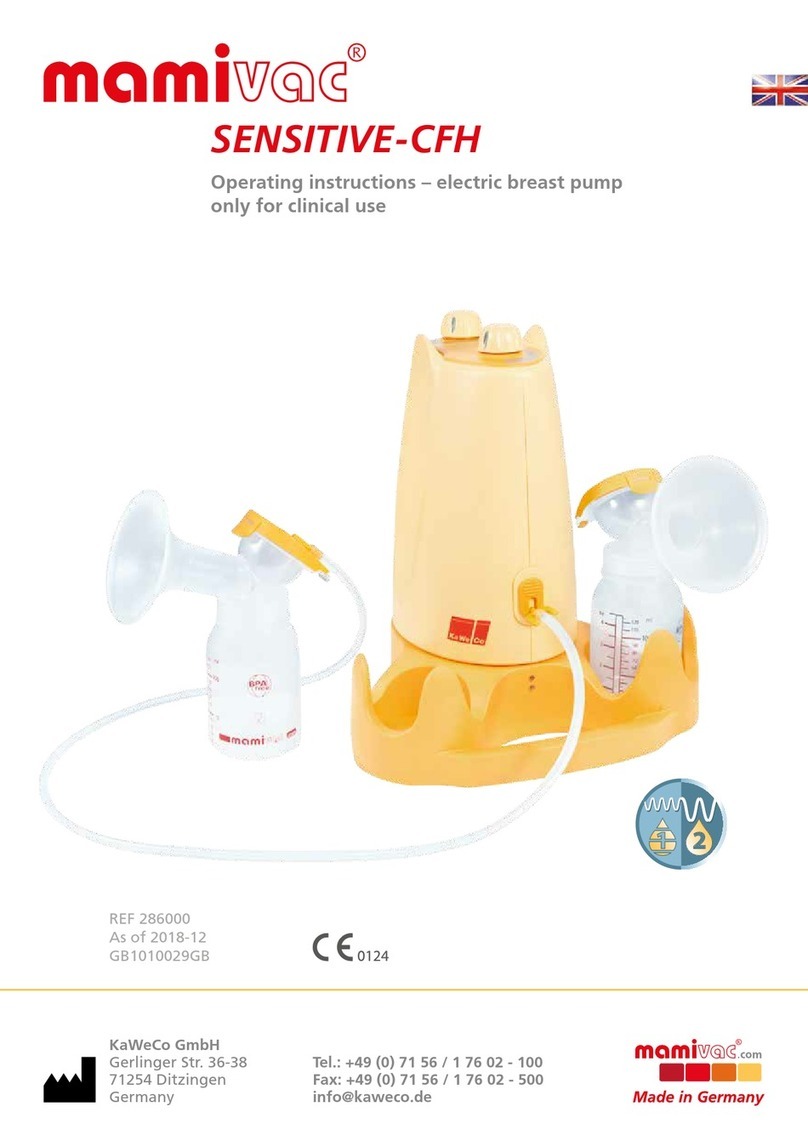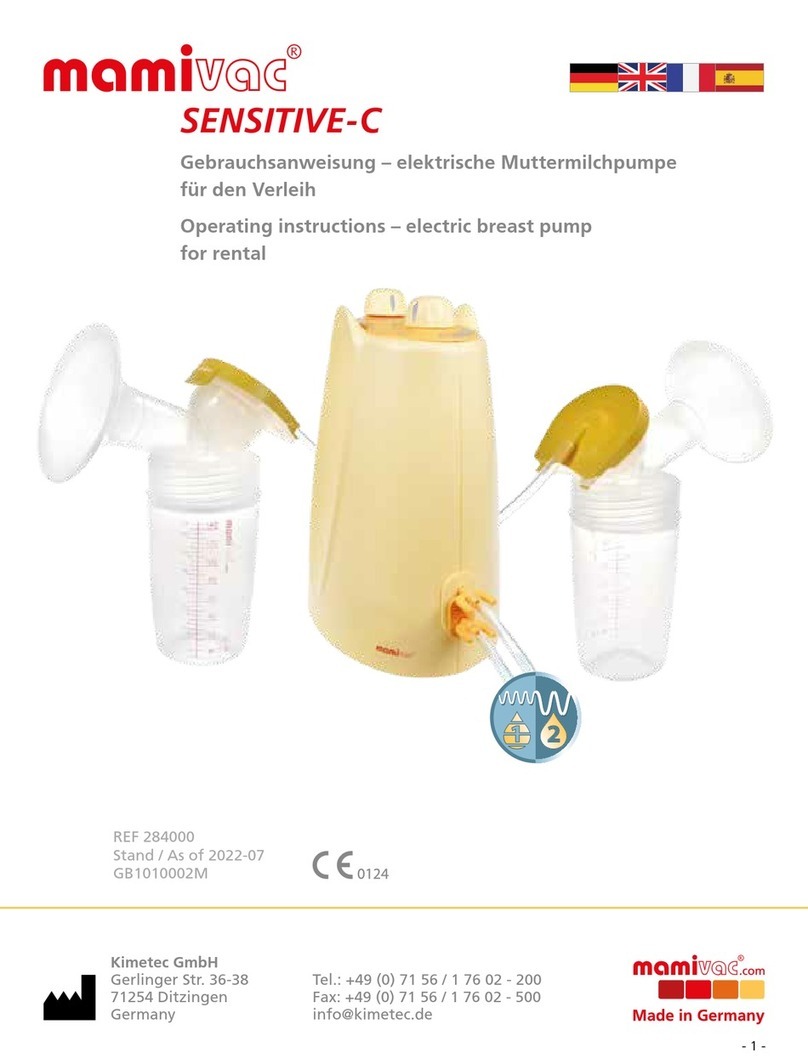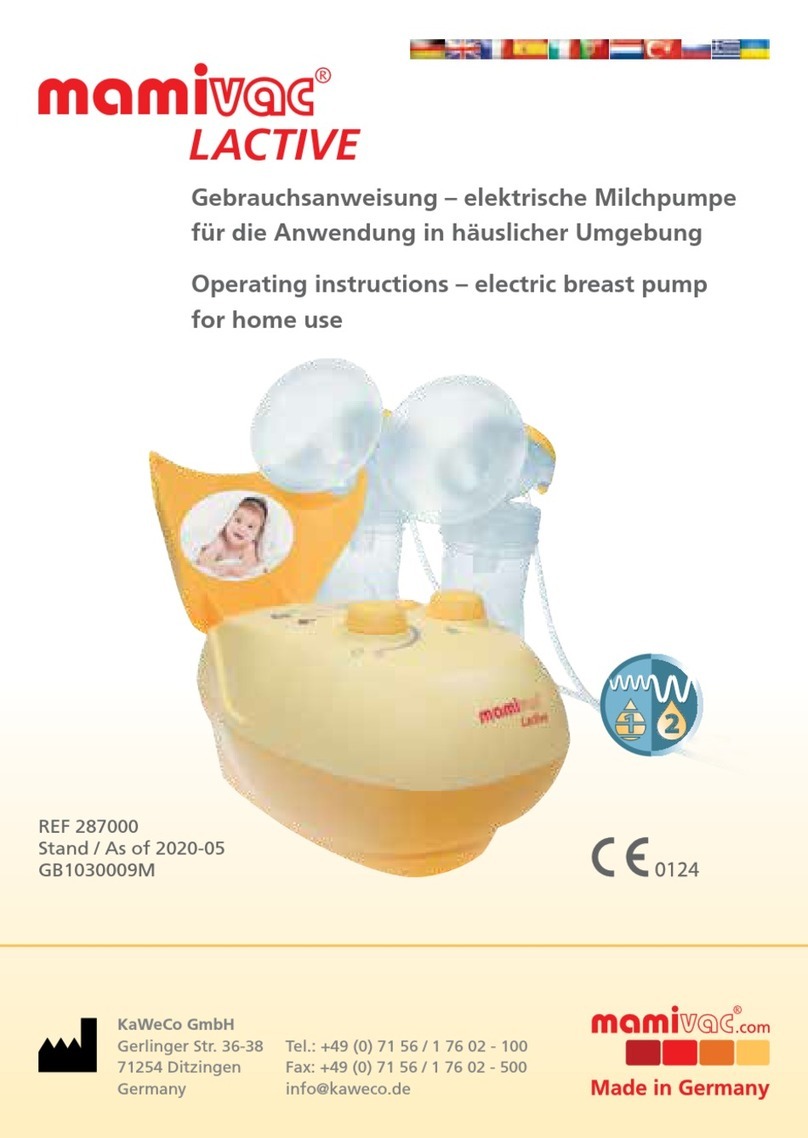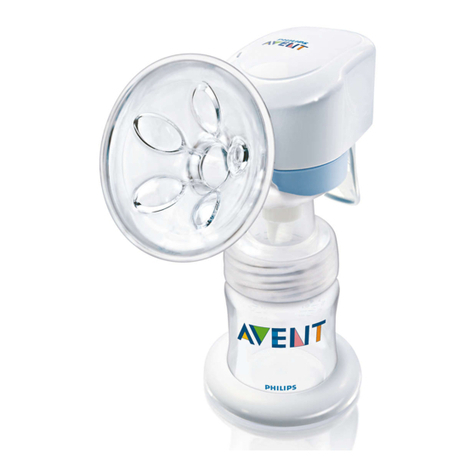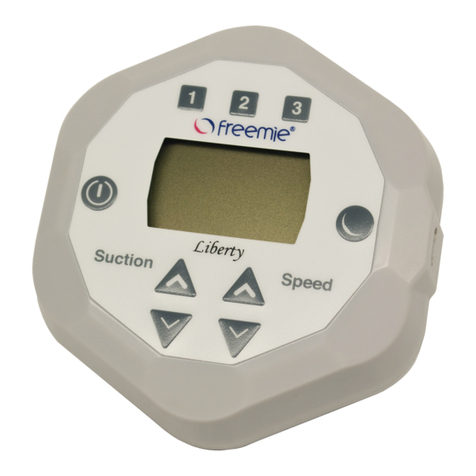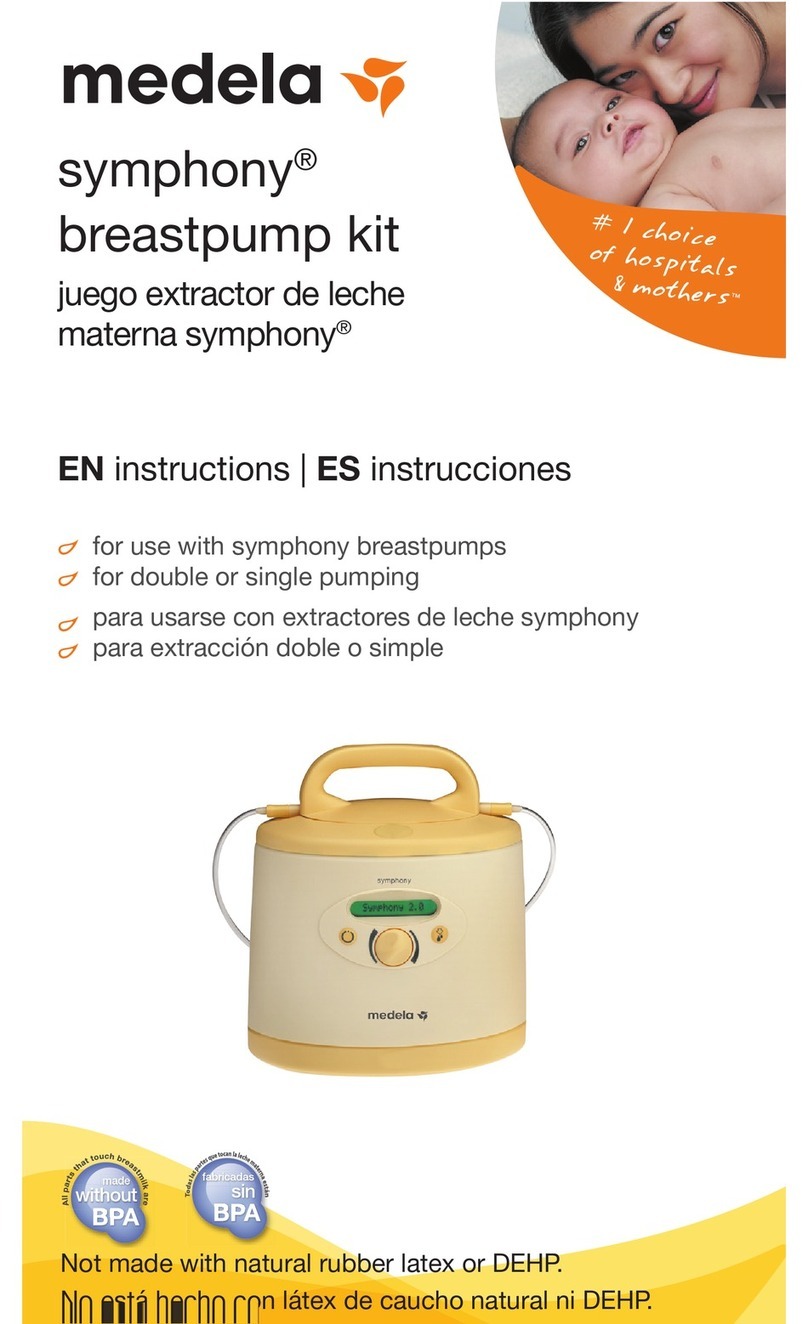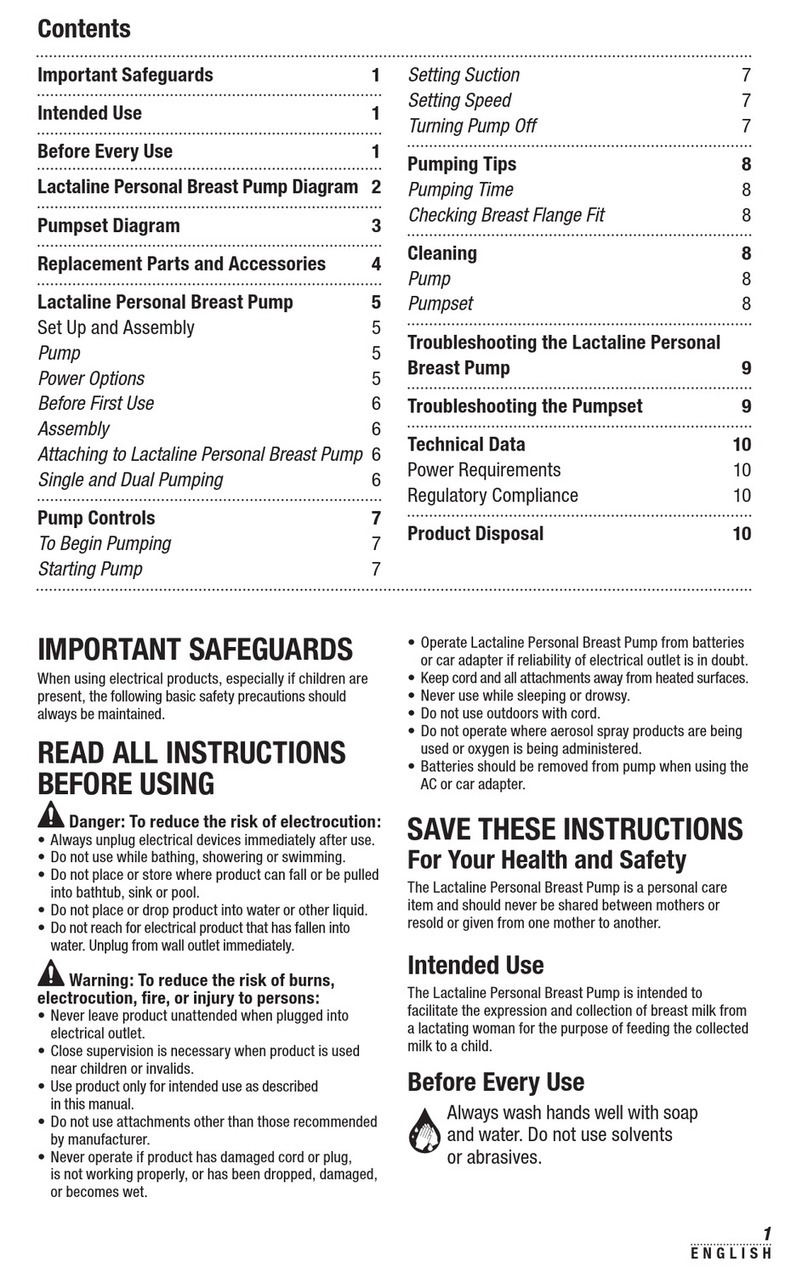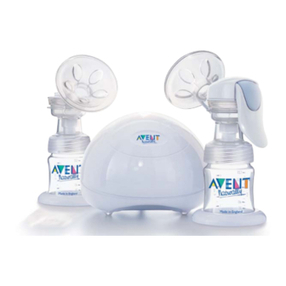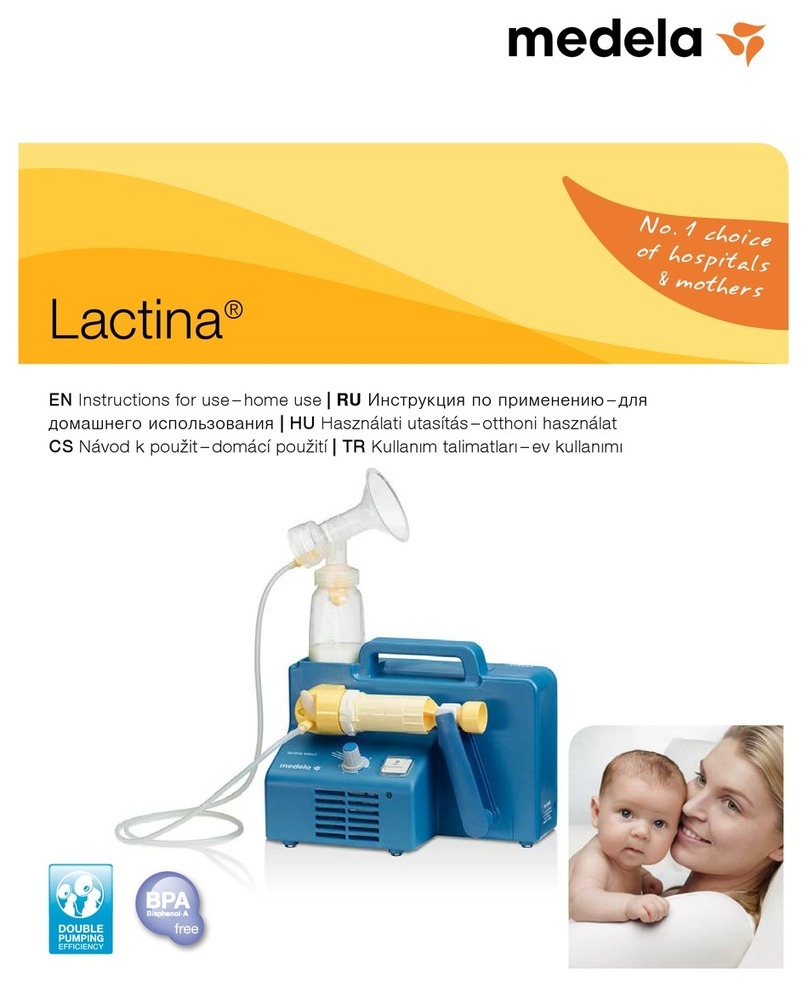mamivac GB1020001M User manual

Tel.: +49 (0) 71 56 / 1 76 02 - 100
Fax: +49 (0) 71 56 / 1 76 02 - 500
info@kaweco.de
Gebrauchsanweisung
Operating Instructions
KaWeCo GmbH
Gerlinger Str. 36-38
71254 Ditzingen
Germany
GB1020001M
Stand / As of 2020-08
EASY

DEUTSCH 1-10
ENGLISH 11-17
FRANÇAIS 18-25
ITALIANO 26-33
ESPAÑOL 34-41
PORTUGUÊS 42-48
TÜRKÇE 49-55
NEDERLANDS 56-63
ελληνικά 64-71
Українська 72-79
Русский 80-87
88-94
2

KaWeCo GmbH
Gerlinger Str. 36-38
71254 Ditzingen
Germany
Zum Abpumpen von Muttermilch bei Stillproblemen, Krankheit oder Trennung
von Mutter und Säugling.
GB1020001D
Stand 2020-08
Sicherheitsvorschriften beachten
Medizinprodukt
Gebrauchsanweisung befolgen
Tel.: +49 (0) 71 56 / 1 76 02 - 100
Fax: +49 (0) 71 56 / 1 76 02 - 500
info@kaweco.de
Transport und Lagerung: -25°C bis +70°C
Betrieb: +5°C bis +40°C
Hersteller
Vor Sonnenlicht schützen

1. Hinweise zur Gebrauchsanweisung
Diese Gebrauchsanweisung gilt für die mamivac® EASY Handmilchpumpe sowie
für alle baugleichen Derivate.
mamivac®EASY REF 281360
mamivac®EASY im Polybeutel REF 281360B
Lesen Sie vor Gebrauch der mamivac®EASY Handmilchpumpe die
Gebrauchsanweisung sorgfältig durch und bewahren Sie diese auf.
4
Inhalt
1. Hinweise zur Gebrauchsanweisung 4
2. Aufbau und Bestandteile 5
3. Zweckbestimmung 6
3.1 Indikation 6
3.2 Kontraindikation 6
3.3 Nebenwirkungen 6
3.4 Patientenzielgruppe/ Anwender 6
4. Allgemeine Hinweise 6
4.1 Funktion der Handmilchpumpe 7
5. Hygiene und Reinigung 8
6. Praktische Tipps 8
6.1 Aufbewahrung von Muttermilch 8
6.2 Zubehör 9
7. Klassifizierung 9
8. Entsorgung 9
9. Ersatzteile 9
10. Gewährleistung 10
11. Technische Daten 10

2. Aufbau und Bestandteile
5
a) Pumpeinheit mit Vakuumregler
b) Hygienedeckel
c) Softeinsatz
d) Brustglocke
e) Silikonventil
f) Flasche
g) O-Ring
h) Flaschendeckel
i) Kolbendichtring
b) c)
d) a)
e)
f)
h)
g) i)

3. Zweckbestimmung
Die Handmilchpumpe mamivac®EASY ist dafür vorgesehen, Muttermilch
schonend und sanft abzupumpen und zu sammeln.
3.1 Indikation
Mögliche Gründe, die das Abpumpen von Muttermilch mit Hilfe einer Pumpe
erforderlich machen, sind: Mastitis (Brustentzündung), schmerzhafte/wunde
Mamillen (Brustwarzen), anatomische Varianten der Mamillen, die ein Stillen des
Säuglings erschweren (z.B. Flach- oder Hohlwarzen), zu geringe Milchbildung,
Milchüberschuss, Frühgeburt, Stoffwechselstörung des Säuglings, anatomische
Fehlbildung beim Säugling im Gesichtsbereich, Saugschwäche des Säuglings,
vorübergehende Erkrankung der Mutter (Medikamenteneinnahme).
3.2 Kontraindikation
Im Allgemeinen kann die Einnahme von Medikamenten Auswirkungen auf das
Stillen des Säuglings haben. Entsprechende Hinweise sind im Beipackzettel des
Arzneimittelherstellers enthalten.
mamivac® EASY darf nicht angewendet werden:
• zur Absaugung von anderen Körperflüssigkeiten wie Blut, Sekret oder Schleim
• zur Absaugung außerhalb des medizinischen Bereichs
• bei anderen Lebewesen.
3.3 Nebenwirkungen
In Einzelfällen kann es zu Irritationen der Haut, wie Rötung oder roten Flecken,
kommen.
3.4 Patientenzielgruppe/Anwender
Stillende Mütter
4. Allgemeine Hinweise
• Prüfen Sie das Produkt vor jeder Anwendung auf äußerliche Beschädigungen
und Funktionstüchtigkeit. Bei Defekten oder Fehlfunktionen darf das Produkt
nicht weiter verwendet werden.
6

• Vor jedem Abpumpen waschen Sie die Hände gründlich mit Seife. Ihre Brust
reiben Sie mit einem feuchten Tuch ab. Verwenden Sie keine Reinigungsmittel
wie Seife oder Alkohol. Damit vermeiden Sie Austrocknungen und Risse der
Brustwarzen.
• Bereiten Sie sich in aller Ruhe auf das Abpumpen vor. Setzen Sie sich bequem
und entspannt hin. Drücken Sie die Brustglocke leicht über die Brustwarze, so
dass diese dicht anliegt. Beginnen Sie mit dem Abpumpen.
• Die Pumpe verfügt über einen Stimulationsmodus, der den Milchfluss anregt. Zur
Unterstützung können Sie zusätzlich mit der anderen Hand die Brust massieren.
• Pumpen Sie abwechselnd an beiden Brüsten, sofern vom Arzt nichts anderes
verordnet ist. Da die Abpumpzeiten von Mutter zu Mutter unterschiedlich sind,
wenden Sie sich bitte ggf. an Ihre Hebamme oder Stillbeauftragte.
• Sollten Sie Schmerzen oder Probleme haben, kontaktieren Sie Ihren Arzt oder
Ihre Hebamme/Stillberaterin.
• Alle im Zusammenhang mit dem Produkt aufgetretenen schwerwiegenden Vor-
fälle sind dem Hersteller und der zuständigen nationalen Behörde zu melden.
4.1 Funktion der Handmilchpumpe
Die Stimulationsphase (1):
Damit sich der Milchfluss einstellt, stellen Sie den Vakuumregler ganz nach links.
Drücken Sie den Pumpengriff mehrmals zügig nach unten. Es wird das natürliche
Saugverhalten des Babys nachgeahmt. Halten Sie den Pumpengriff für ca. 3-4
Sekunden gedrückt, sodass die Milch in die Flasche fließen kann.
Die Pumpphase (2):
Stellen Sie den Vakuumregler nach rechts, wenn die Milch fließt. Jetzt pumpen
Sie, indem Sie den Pumpengriff nach unten drücken, halten den Griff in dieser
Stellung, bis sich das Vakuum von selbst abgebaut hat.
Sollte sich Ihr Milchfluss nicht sofort einstellen, entspannen Sie sich und versuchen
Sie es erneut, ggf. auch zu einem späteren Zeitpunkt.
7

Sollte das Abpumpen schmerzhaft sein, benutzen Sie die Pumpe nicht mehr!
Kontaktieren Sie Ihren Arzt oder Ihre Hebamme/ Stillberaterin. Bitte achten Sie
darauf, dass nicht zu viel Milch in die Flasche gepumpt wird und halten Sie die
Pumpe immer aufrecht.
5. Hygiene und Reinigung
Vor dem ersten Gebrauch reinigen Sie bitte die Teile b) bis h) und kochen
sie mind. 5 min in kochendem Wasser aus oder geben Sie sie in ein
Dampfdesinfektionsgerät, z.B. einen Vaporisator. Bitte entsprechende Hinweise
des Herstellers beachten.
Bitte nicht in das Mikrowellengerät geben.
• Bitte verwenden Sie keine chemischen Desinfektionsbäder, Lösungs- oder
Scheuermittel.
• Alle Teile b) bis h) können mit handelsüblichem Geschirrspülmittel von
Hand oder in der Geschirrspülmaschine gereinigt werden.
• Vor jedem weiteren Gebrauch reinigen Sie die Teile, die mit Milch in Be-
rührung gekommen sind und prüfen diese auf Funktionstauglichkeit und
einwandfreien Zustand.
• Nach dem Reinigen müssen Sie die Teile b) bis h) gründlich mit lau-
warmem Wasser abspülen. Dadurch entfernen Sie evtl. anhaftende
Spülmittelreste, insbesondere bei den Komponenten, die direkt mit
der Muttermilch in Berührung kommen. Benutzen Sie evtl. eine Bürste,
um an schwer zugängliche Stellen zu gelangen.
• Setzen Sie die Handmilchpumpe laut Zeichnung unter »Aufbau und
Bestandteile« zusammen.
• Bei Schwergängigkeit des Kolbens geben Sie etwas Talkum oder Babypuder
auf den Kolbendichtring (i).
6. Praktische Tipps
Die gereinigten und trockenen Teile in ein sauberes Tuch einwickeln und in
einem Behälter aufbewahren, wenn sie nicht gebraucht werden.
6.1 Aufbewahrung von Muttermilch
Muttermilch hält sich:
• frisch abgepumpt bei Zimmertemperatur (16°-29°C) 3-4 Stunden
8

• im hinteren Bereich des Kühlschranks (unter 4°C) 3 Tage
• im Gefrierschrank (-18°C) 6 Monate
Dazu befüllen Sie die verwendeten Flaschen oder Gefäße nur zu 2/3 und
vermerken Sie das Abfülldatum. Anstatt einer Flasche können Sie auch unsere
speziell dafür entwickelten mamivac®Muttermilch-Gefrierbeutel [REF 282100
PZN (D) 1279777] verwenden. Tauen Sie die gefrorene Muttermilch nicht in der
Mikrowelle auf, sondern bei Raumtemperatur. Bei Bedarf stellen Sie die Flasche
oder den Beutel in warmes Wasser (37°C). Nach dem Auftauen schütteln Sie
das Gefäß oder den Beutel leicht durch, damit sich die Milch vermischt.
6.2 Zubehör
• Softeinsatz REF 281215
• mamivac®Muttermilch-Gefrierbeutel VPE = 20 Stück REF 282100
• Hygienedeckel REF 49010147
7. Klassifizierung
Klassifizierung: Medizinprodukt der Risikoklasse I
8. Entsorgung
Ihre mamivac® EASY Handmilchpumpe entsorgen Sie bitte gemäß Ihren lokal
geltenden Abfallvorschriften.
9. Ersatzteile
Silikonventil REF 49054105
Kolbendichtring REF 49054125
O-Ring REF 49054005
Hygienedeckel REF 49010147
Brustglocke Standard REF 28012011
Flasche 120ml mit Schraubdeckel REF 28011131
Rückholfeder REF 49040100
37°C
9

10. Gewährleistung
Durch die Missachtung der Hinweise in dieser Gebrauchsanweisung oder durch
die nicht bestimmungsgemäße Verwendung erlischt der Gewährleistungsan-
spruch und die KaWeCo GmbH haftet nicht für Personen- und Sachschäden,
die darauf zurückzuführen sind.
11. Technische Daten
Vakuum max: -33 kPa (±15 %)
Größe (H x B x T): 166 x 152 x 75 mm
Gewicht: ca. 110 g
10

KaWeCo GmbH
Gerlinger Str. 36-38
71254 Ditzingen
Germany
For expressing breast milk in case of breastfeeding problems, illness or
separation of mother and infant.
Phone: +49 (0) 71 56 / 1 76 02 - 100
Fax: +49 (0) 71 56 / 1 76 02 - 500
info@kaweco.de
GB1020001GB
As of: 2020-08
Observe safety instructions
Medical device
Observe operating instructions
Tranportation and storage: -25°C to +70°C
Operation: +5°C to +40°C
Manufacturer
Protect from sunlight

1. Notes on the operating instructions
These operating instructions are valid for the mamivac®EASY manual breast
pump as well as all other derivates of identical design.
mamivac®EASY REF 281360
mamivac®EASY in poly bag REF 281360B
Before using the mamivac®EASY manual breast pump, read the
operating instructions carefully and keep them for future reference.
12
Inhalt
1. Notes on the operating instructions 12
2. Assembling and components 13
3. Purpose 14
3.1 Indication 14
3.2 Contraindication 14
3.3 Side effects 14
3.4 Target group of patients/users 14
4. General notes 14
4.1 Functioning of the manual breast pump 15
5. Hygiene and cleaning 16
6. Practical tips 16
6.1 Storing breast milk 16
6.2 Accessories 17
7. Classification 17
8. Disposal 17
9. Spare parts 17
10. Warranty 17
11. Technical data 17

2. Assembling and components
a) Pump unit with vacuum control
b) Hygienic cover
c) Soft insert
d) Breast shield
e) Silicone valve
f) Bottle
g) O-ring seal
h) Bottle cap
i) Piston seal ring
13
b) c)
d) a)
e)
f)
h)
g) i)

3. Purpose
The manual breast pump mamivac®EASY is used in order to genty and softly express
and collect breast milk.
3.1 Indication
Breastfeeding problems that require the use of a breast pump may be: mastitis (in-
flammation of mammary glands), aching or sore mamillae (nipples), anatomic variants
of the mamillae which make feeding the infant difficult (flat or inverted nipples), in-
sufficient or excessive milk production, premature delivery, metabolic disorders of the
infant, anatomic disorder in the face of the infant, poorly sucking infant, temporary
illness of the mother (medication intake).
3.2 Contraindication
Taking medication in general may affect breastfeeding an infant. The patient informa-
tion leaflets of the pharmaceutical companies contain appropriate information.
mamivac®EASY may not be used:
• to suction other body fluids, such as blood, secretions or mucus
• to suction outside the medical field
• on other living beings.
3.3 Side effects
In individual cases, the skin may be irritated resulting in redness or red spots.
3.4 Target group of patients/users
Breastfeeding mothers
4. General notes
• Prior to using the product, always check it for external damage and proper work-
ing. Do not use the product in case of faults or faulty functions.
• Prior to expressing, wash your hands thoroughly with soap and wipe your breast
with a damp cloth. Do not use soap or alcohol as detergent to avoid dry, soar or
cracked nipples.
• Prepare yourself for the expressing with ease. Take a comfortable and relaxed seat.
Gently press the breast shield over the nipple for a tight contact. Start to express milk.
14

• The pump has a stimulation mode to trigger the let-down reflex. You can also use
your free hand for an additional breast massage.
• Express from both breasts alternately, unless instructed otherwise by the doctor.
Since expressing times strongly depend on the individual mother, you are asked to
contact your midwife or lactation consultant.
• If you feel pain or experience any problems, contact your doctor or midwife/lacta-
tion consultant.
• Any severe incident that occurs in connection with the product shall be reported to
the manufacturer and the responsible national authority.
4.1 Functioning of the manual breast pump
The stimulation phase (1):
To trigger the let-down reflex, turn the vacuum control to the very left. Press
the pump handle dynamically downwards several times. This imitates the baby’s natu-
ral sucking behaviour. Keep the pump handle pressed for 3-4 seconds, so
that the milk starts to flow into the bottle.
The expressing phase (2):
When the milk is flowing, turn the vacuum control to the right. You can express now
by pressing the pump handle downwards and keeping the handle pressed until the
vacuum has been released.
If the milk does not start to flow right away, relax and try again – even at a later point
in time.
If expressing causes pain, do not use the pump anymore! Please contact your doctor
or your midwife/lactation consultant. Make sure not to express too much milk into the
bottle. Keep the pump in an upright position.
15

5. Hygiene and cleaning
Before you use the breast pump for the first time, clean components b) to h) and boil
in boiling water for at least 5 min. or use a steam disinfection device, such as a steri-
liser for instance. Please observe the manufacturer’s corresponding notes.
Do not use a microwave oven.
• Do not use chemical disinfection baths, solvents or abrasives.
• All components b) to h) can be cleaned with commercial washing-up liquids by
hand or in the dish washer.
• Prior to using the pump the next time, clean the parts which came into contact
with milk, and check them for proper functioning and condition.
• After cleaning, rinse components b) to h) thoroughly with lukewarm water to
remove residues of the washing-up liquid, especially on those components which
come into direct contact with breast milk. You might use a brush to clean areas
which are difficult to reach.
• Assemble the manual breast pump according to the drawing in »Assembling and
components«.
• In case the piston is sticky, apply talcum or baby powder to the piston seal ring (i).
6. Practical tips
Wrap the cleaned and dry parts in a clean cloth and store them in a container when not in use.
6.1 Storing breast milk
Breast milk can be stored as follows:
• Freshly expressed at room temperature (16-29°C) 3-4 hours
• In the rear of the fridge (below 4°C) 3 days
• In the freezer (-18°C) 6 months
Fill the used bottles or containers to two thirds only and write down the fill date.
Instead of a bottle, you can also use our specially designed mamivac®breast milk
freezer bags [REF 282100]. Do not defrost frozen breast milk in the microwave,
but at room temperature. Place the bottle or bag in warm water (37°C) as required.
After defrosting, gently shake the container or bag to mix the milk.
16

6.2 Accessories
• Soft insert REF 281215
• mamivac®breast milk freezer bags PU = 20 pcs. REF 282100
• Hygienic cover REF 49010147
7. Classification
Medical product of risk class I
8. Disposal
Please dispose of your mamivac®EASY manual breast pump in accordance with your
local disposal regulations.
9. Spare parts
Silicone valve REF B49054105
Piston seal ring REF 49054125
O-ring seal REF 49054005
Hygienic cover REF 49010147
Standard breast shield REF 28012011
Bottle 120ml with cap REF 28011131
Retaining spring REF 49040100
10. Warranty
Ignoring the notes in these operating instructions or an improper use of the device will
void any warranty claims. KaWeCo GmbH rejects any liability for personal injuries and
material damages arising from this.
11. Technical data
Max. vacuum: -33 kPa (±15 %)
H x W x D: 166 x 152 x 75 mm
Weight: ca. 110 g
17

KaWeCo GmbH
Gerlinger Str. 36-38
71254 Ditzingen
Germany
Pour le tirage en cas de problèmes d'allaitement, en cas de maladie ou d'une
séparation du bébé de sa mère.
Tél. : +49 (0) 71 56 / 1 76 02 - 100
Fax : +49 (0) 71 56 / 1 76 02 - 500
info@kaweco.de
GB1020001FR
Édition 2020-08
Observer les consignes de sécurité
Dispositif médical
Respectez le mode d’emploi
Transport et emmagasinage : de -25°C
jusqu'à +70°C
Fonctionnement : de +5°C jusqu'à +40°C
Fabricant
Ne pas exposer aux rayons solaires

1. Remarques concernant le mode d'emploi
Ce mode d'emploi s'applique au tire-lait manuel mamivac®EASY ainsi qu'à tous
les produits dérivés de construction identique.
mamivac®EASY REF 281360
mamivac®EASY en sachet en polyéthylène REF 281360B
Lisez attentivement le mode d'emploi de votre tire-lait manuel
mamivac®EASY avant de l'utiliser et conservez le mode d'emploi
pour un usage ultérieur.
19
Sommaire
1. Remarques concernant le mode d'emploi 19
2. Structure et composants 20
3. Fonction 21
3.1 Indication 21
3.2 Contre-indication 21
3.3 Effets indésirables 21
3.4 Groupe cible de patients/Utilisateurs 21
4. Remarques générales 21
4.1 Fonctionnement du tire-lait manuel 22
5. Nettoyage hygiénique et entretien 23
6. Conseils pratiques 23
6.1 Conservation du lait maternel 23
6.2 Accessoires 24
7. Classification 24
8. Élimination 24
9. Pièces de rechange 24
10. Garantie légale 25
11. Données techniques 25

2. Structure et composants
20
a) Unité de tirage avec le régulateur de pression
b) Couvercle hygiénique
c) Embout souple
d) Cloche mammaire
e) Soupape en silicone
f) Flacon
g) Joint torique
h) Couvercle du flacon
i) Joint d’étanchéité du piston
b) c)
d) a)
e)
f)
h)
g) i)
Table of contents
Languages:
Other mamivac Breast Pump manuals

